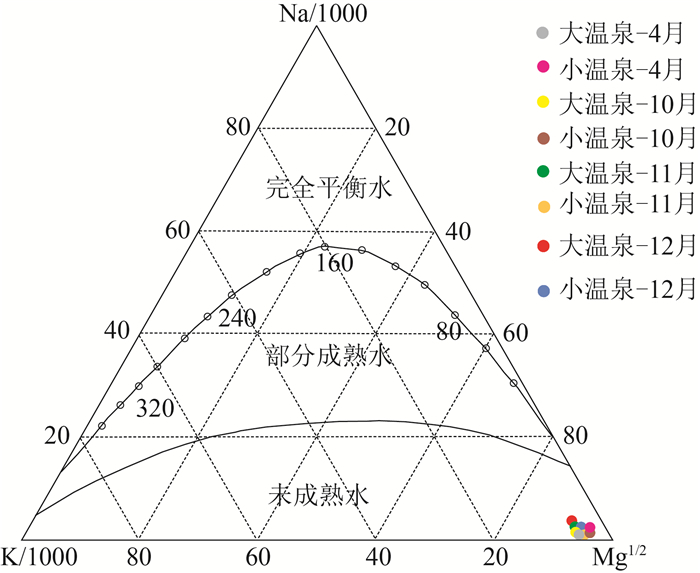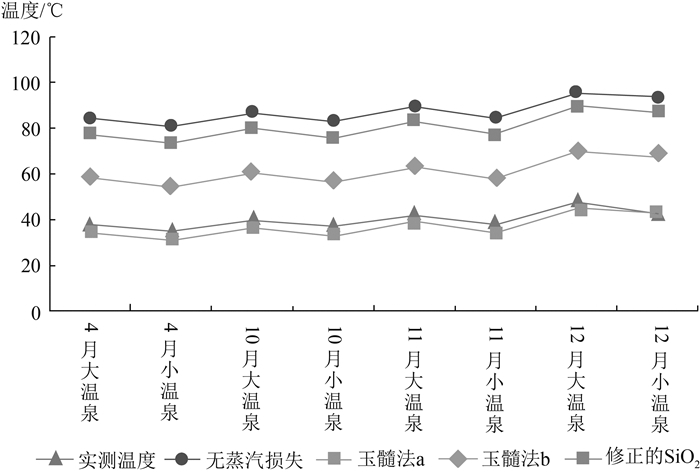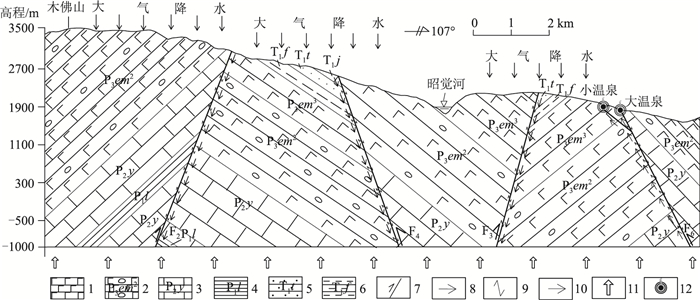Analysis of geothermal temperature and genetic model in Zhaojue County of Sichuan Province
-
摘要:
热储温度是划分地热系统成因类型和评价地热资源潜力的重要参数。为合理开发和利用四川昭觉县的地热资源,巩固脱贫攻坚成果,选择四川昭觉县竹核温泉为研究对象,利用无蒸汽损失石英和有蒸汽损失石英温标法、玉髓法a和玉髓法b,修正的SiO2温标法,K-Mg、Na-Li、Na-K、Na-K-Ca等阳离子温标法计算深部热储温度,并利用Na-K-Mg三角图解法和矿物饱和指数法检验所用方法的可靠性。结果表明,研究区利用SiO2(无蒸汽损失)温标法和修正后的SiO2温标法计算所得出的热储平均温度更适用,其中竹核温泉中大温泉的热储温度范围在81~93℃之间,平均热储温度86℃,小温泉的热储温度范围在77~90℃之间,平均热储温度82℃;竹核温泉来自深部的大地热流,受控于木佛山断层和竹核断层2条主控断裂。
Abstract:Geothermal temperature is an important parameter for classifying the genetic types of geothermal systems and evaluating the geothermal resource potential.In order to rationally develop and utilize the geothermal resources in Zhaojue County of Sichuan Province, and consolidate the achievements of poverty alleviation, the geothermal temperature of the Zhuhe hot springs in this area was studied.Various methods were used to calculate its deep thermal storage temperature, including steam-free loss quartz and steam loss quartz temperature scales, chalcedony a and b, modified SiO2 temperature scale, K-Mg, Na-Li, Na-K, Na-K-Ca and other cationic temperature scales.The reliability of the above methods is tested by Na-K-Mg triangulation method and mineral saturation index method.The results show that the average temperature calculated by SiO2 (without steam loss) temperature scale method and modified SiO2 temperature scale method are most suitable for this hot springs.The thermal temperature of its large hot springs ranges from 81℃ to 93℃, averaging 86℃, and that of small hot springs from 77℃ to 90℃, averaging 82℃.It reveals that the Zhuhe hot springs results from the deep terrestrial heat flow and is controlled by Mufoshan fault and Zhuhe fault.
-
能源与矿产资源是国民经济发展的物质基础,每年向国民经济运转输入金属矿物达到5×104 t[1],煤炭40×108 t,支撑200多座矿业城市的生存和发展,从业人员超过500万人,稳定的矿产品供给对保证国家经济安全运行、保障社会的稳定、中国持续快速发展有重大意义。
美国很早就建立了矿产资源储量数据库并定期保持更新,20世纪70—80年代,美国前矿业局建设了市场经济国家矿产可供性系统(Mineral Availability System,缩写为MAS)[2]。该系统不是一个简单的数据库,而是一个系统工程,原是集基础数据收集整理、信息统计数据库、数据评价分析系统于一体的决策支持系统,目前已停止更新。陈晓红等建设了面向问题决策的金属矿产保障开发决策支持系统[1, 3-4]。
矿山的地质和技术经济条件决定了矿山查明矿产储量在未来一定时期内进行工业开发的经济效益和可供资源储量,原国土资源部于2013年完成了全国矿产资源利用现状国情调查,摸清了矿产资源家底、矿山开发利用现状,建成了详尽的中国矿产资源国情数据库,笔者融合国情调查数据库、矿山实地调查技术经济数据等数据源,建成了矿产资源大数据平台作为动态分析的基础,构建保障程度评价各个关键技术环节评价分析模型,开发矿产资源保障程度动态分析系统,动态模拟未来资源供需形势,掌握决策主动权。
1. 保障程度动态分析系统架构设计
系统依照大数据平台-矿产资源可供性分析子系统-保障程度分析子系统-决策分析子系统多层次建设思路,构建适用于不同矿床类型、不同矿种的矿床技术经济评价、决策支持计算机专家系统软件,测算不同市场条件下矿产资源可供价格等关键参数,模拟预测未来资源保障形势,为保障程度研究工作提供定量分析指标,形成保障程度动态分析系统。
资源保障程度分析主要分为5个阶段(图 1),一是面上数据搜集,融合矿山储量、产量、采矿、经济等相关数据;二是大数据平台搭建,分析各数据源关键内容和相关关系,设计合理、高效的多源异构平台架构;三是可供性分析,主要分为五小步,分别为①设置公共参数:待分析矿种、预测年限、矿石类型等,②测算可供价格,③预测未来价格变化趋势,④可供量测算,⑤可供年限预测;四是保障程度动态分析,根据已获得的消费模型预测消费量;五是预报预警决策支持。
2. 矿产资源保障程度大数据平台搭建
基础数据库是技术经济评价和可供性分析的基础,但是大量数据结构不同,形式多样,需要一个高效智能的管理平台整合利用,搭建异构多源数据库管理平台。首先需要处理本次矿山调研搜集的矿山技术经济数据,单个矿山和矿区的技术经济系数,如采矿方法、入选品位、选矿方法、矿产品销售、生产成本、采选回收率等,形成保障程度矿山经济技术参数调查成果数据库。在此基础上保障程度动态分析还需要大量基础数据,横向上分别取自中国矿产资源国情调查、全球矿业活动数据库、矿产技术经济数据库等,这些数据库存在数据结构不同、文件格式各异(ARCGIS、MAPGIS)、坐标系统不统一的问题,最大的问题是数据项定义不同、度量单位和对象不统一。由于这些数据库大部分存在动态更新的问题,需要开发软件进行动态转换,随时可以提取最新的数据。纵向上还需要搜集国家基础设施、矿山附属设施、环保方案等,以及与经济社会和市场有关的资料,如税率、费率、利率、折旧率、矿产品市场价格等。
矿山技术经济数据调查填报系统:重点针对生产矿山,通过调查问卷和实地调研,进行矿山资料和基础数据收集、整理、分析,提取生产矿山的基础数据,包括地质矿产、保有资源储量、工业指标信息、采矿信息、选矿信息、矿山建设投资信息、矿山经济信息等,为矿山技术经济评价和可供性分析做好基础信息数据准备。未利用矿区侧重调查了解矿区信息、矿床地质信息和可供性评价信息。笔者通过保障程度矿山经济技术参数调查填报系统,调查上报经济技术参数;完成数据搜集和统计, 形成了调查成果数据库。矿山调查表系统见图 2。
3. 可供性分析
可供性分析是保障程度分析中最重要的一个环节,可以分为5步,分别为:①设置可供性参数:分析矿种、预测年限、矿石类型等,②测算可供价格,③预测未来价格变化趋势,④可供量测算,⑤可供年限预测。据数据流程,编程实现了矿山可供性分析子系统, 主要包括可供性分析参数计算模块、无调查表数据矿山匹配模块、未占用资源可供性分析模块、矿山可供性一览表模块、矿山可供性分析统计图模块、可供价格-可供量统计模块。
3.1 可供价格与可供量
可供价格测算可以看作测算矿山在现有的数量规模、采矿成本、选矿成本、运输距离、投资收益率等多因素综合作用下的完全成本,可供量测算是利用计算机程序的计算能力,实现评价某个固定时间段、特定地区(矿集区)内的矿山供应能力。通过建立占用矿山(未占用资源)类比法推算矿山未知经济技术参数,形成涵盖中国所有已查明资源的可供性评价参数,采用现金流量法等财物分析模型测算,计算矿山(矿区、省、市)未来某个时间段的可供价格和可供量,形成可供性评价成果数据集,为进一步系统保障程度分析系统打下基础。可供性分析系统的数据流程图反映数据在系统各个环节之间的流动情况(图 3)。
3.2 矿产品价格预测与可供产量测算
矿产品的价格取决于特定时刻的需求和供应状况,矿产品价格是供求平衡相等时的均衡价格。矿产品的价格主要涉及2个方面,一是长期价格趋势,二是短期价格波动。在竞争条件下,长期价格趋势是矿产品成本的函数,即使在不景气的市场条件下,成本也是确定价格的重要组成部分。矿产品的长期成本一般是趋于下降的,其长期价格趋势也是下降的。由于供求和需求状况的短期无规律变化,矿产品一般都有严重的短期价格波动特点。通常来说,矿产品短期价格波动受总经济周期、国际政治经济形势、期市基金和投机的影响。
对矿产品价格进行长期预测分析时,由于时间跨度过大,市场不确定性因素难以确定,用一般的预测方法(如时序法、供求法)进行预测时,准确性较差。本次主要采用2种方法对矿产品价格进行预测分析,一是马尔科夫随机过程模型(维纳过程模型),二是多元回归分析模型。
矿产品价格波动模型采用维纳过程来模拟。维纳过程是马尔科夫随机过程的一种特殊形式,也称为布朗几何漂移运动。可用下述方程描述矿产品价格的连续波动过程。
设S为时间t时的矿产品价格,t为时间,σ为矿产品价格波动率,μ为矿产品预期增长率,则有:
dS=μSdt+σSdz (1) 或
dSS=μdt+σdz (2) 式中dS表示在某种短期时间内矿产品价格的波动;dz表示标准维纳过程的增量,且dz=ε√dt;z为遵循维纳过程;ε为标准正态分布中随机抽取的一个随机值。
该模型的离散形式为:
ΔSS=μΔt=σΔt (3) 方程(3)表明ΔSS服从均值为μΔt,标准差为σ√Δt的正态分布,即
ΔSS∼N(μΔt,σ√Δt) (4) 式中μ为矿产品预期增长率,可根据历史资料和对价格的预期判断得到;σ为矿产品价格波动率,可根据历史资料和对价格的预期判断得到估计值。
设n为观察次数,Si为第i时间间隔末的矿产品价格,τ是以年为单位的时间间隔长度(单位:a)。令μi=lnSiSi−1,i=1,2, …,则Si=Si-1eui,ui为第i时间间隔后的连续复利系数。μi的标准差σs的估计值为
σs=√1n−1n∑i=1μ2i−1n(n−1)(n∑i=1μi)2 (5) 由定理可知:lnSiS˜ N((μ−σ22),σ√τ),所以μi∼N((μ−σ22),σ√τ)。又σs是μi的标准差,所以σs=σ√τ,矿产品价格波动率σ=σs√τ。由此可知,通过矿产品价格的历史数据,可以估计出其价格波动率。
对于ΔSS∼N(μΔt,σ√Δt),μ, σ为已知数,Δt为矿产品价格变化的时间段,为一常数。可利用蒙特卡洛模拟法对矿产品的价格进行随机模拟,得到矿产品价格在不同时刻的概率分布,每年度的模拟价格作为该年度的矿产品价格。
可供产量和可供年限测算综合分析未来价格趋势和矿山可供价格,遵循市场经济规律,统计保有资源储量,预测未来矿山生产能力。
4. 保障程度分析子系统与决策支持子系统
保障程度动态分析支持系统是在基础数据库系统和可供性分析系统的基础上进一步进行需求分析,根据“S”形预测方法理论[5]和多元统计回归算法[6],预测矿产资源的未来需求及价格的变化[7-8],与可供性评价的可供量进行供需分析。
保障程度分析系统主要包括矿产资源消费量预测模块和保障程度分析模块。
(1) 矿产资源消费量预测模块
类比对应国家的矿产消费模型,使用模型预测中国对应矿产的消费量,根据已经设置的相关参数预测中国对应矿产的消费量。点击[预测],得到中国对应矿产的消费量预测一览表及消费趋势图(图 4)。
(2) 保障程度分析模块
决策支持系统是在保障程度分析结果的基础上,实现保障程度的动态数据展示,支持决策,主要包括以下功能:①敏感性分析;②成本、价格动态分析;③可采储量保障程度动态分析及预测;④产能、产量动态分析及预测。
5. 结语
(1) 市场经济条件下矿产资源受市场价格影响,矿山的地质技术经济等条件决定了其可供价格、可供储量和可供产量。
(2) 未来国际形势、技术变革变化莫测,通过构建适用于不同矿床类型、不同矿种的矿床技术经济评价、决策支持计算机专家系统软件,可测算不同市场条件下矿产资源可供价格等关键参数,模拟预测未来资源保障形势,为保障程度研究工作提供定量分析指标。未来可依靠大数据和数学模型模拟多种情形下的资源供需形势,用多种分析图表工具可视化展示供需形势辅助决策制定,兵棋推演,分析中国资源供需边界,未雨绸缪掌握未来主动权。
致谢: 论文在撰写过程中得到中国地质科学院水文地质环境地质研究所王婉丽副研究员的指导,在此表示衷心的感谢。 -
图 1 四川昭觉县竹核温泉地质简图
Qhdl—第四系全新统坡积;Qhalp—第四系全新统冲洪积;Qhal—第四系全新统冲积;Qp3gfl—第四系晚更新统冰水堆积;Qp2gfl—第四系中更新统冰水堆积;J1-2z—下侏罗统自流井组;T3x3—上三叠统须家河组三段;T3x2—上三叠统须家河组二段;T3x1—上三叠统须家河组一段;T2l—中三叠统雷口坡组;T1j—下三叠统嘉陵江组;T1t—下三叠统铜子街组;T1f—下三叠统飞仙关组;P3em3—上二叠统峨眉山玄武岩组三段;P3em2—上二叠统峨眉山玄武岩组二段;P2y—中二叠统阳新组;S2d—中志留统大路寨组;S2sf—中志留统嘶风崖组;S1hg—下志留统黄葛溪组;
1—断层;2—产状;3—河流;4—温泉;5—常温泉Figure 1. Simplified geological map of the Zhuhe hot springs in Zhaojue County of Sichuan Province
表 1 四川昭觉县竹核温泉取样情况
Table 1 Sampling of the Zhuhe hot springs in Zhaojue County of Sichuan Province
采样点 2019年4月 2019年10月 2019年11月 2019年12月 大温泉 小温泉 大温泉 小温泉 大温泉 小温泉 大温泉 小温泉 取样时泉口温度/℃ 38.00 35.00 40.00 37.00 42.00 38.00 48.00 43.00 pH 7.96 7.83 8.20 7.93 8.06 7.95 8.09 7.91 TDS/(mg·L-1) 109.78 153.69 150.67 152.19 156.10 155.60 175.23 168.24 溶解氧/(mg·L-1) 4.14 2.46 4.27 2.48 4.05 2.54 4.16 2.51 HCO3-/(mg·L-1) 62.26 155.65 137.95 145.02 159.20 159.20 155.23 166.87 SO42-/(mg·L-1) 11.53 11.06 12.28 11.54 12.20 11.20 10.73 10.28 Cl-/(mg·L-1) 5.58 4.38 7.54 6.35 2.00 2.00 6.71 5.86 CO32-/(mg·L-1) 0.00 0.00 1.74 1.74 0.00 0.00 7.63 0.00 Ca2+/(mg·L-1) 15.31 21.65 15.97 23.87 16.30 23.80 15.67 21.70 Mg2+/(mg·L-1) 1.86 2.98 1.87 2.73 1.60 2.70 1.63 2.56 K+/(mg·L-1) 3.16 2.50 3.45 2.72 3.50 2.80 4.62 3.66 Na+/(mg·L-1) 41.22 33.29 38.85 30.72 40.90 33.50 50.62 40.74 F-/(mg·L-1) 1.80 1.46 1.63 1.40 1.80 1.40 1.59 1.20 SiO2/(mg·L-1) 33.68 31.10 35.68 32.66 38.15 33.59 43.94 41.42 Fe/(μg·L-1) 5.70 8.60 6.70 9.20 7.20 8.60 6.90 8.20 Ba/(μg·L-1) 68.74 46.45 45.00 40.50 67.60 46.40 79.50 50.20 Sr/(μg·L-1) 230.29 220.20 220.00 250.00 270.00 270.00 260.00 250.00 Mn/(μg·L-1) 0.66 0.08 0.53 0.17 0.91 0.22 0.96 0.13 Al/(μg·L-1) 3.02 2.24 5.78 2.96 9.81 3.23 12.80 3.48 Pb/(μg·L-1) < 0.04 < 0.04 < 0.04 < 0.04 < 0.04 < 0.04 < 0.04 < 0.04 Li/(μg·L-1) 95.00 70.00 154.00 115.00 144.00 111.00 256.00 199.00 Cu/(μg·L-1) 0.61 0.64 0.58 0.75 0.41 0.45 0.57 0.20 Zn/(μg·L-1) < 0.09 1.24 < 0.09 < 0.09 < 0.09 < 0.09 < 0.09 < 0.09 表 2 竹核温泉地下热水热储温度
Table 2 Heat storage thermometer of geothermal water in zhuhe hot springs
℃ 采样时间 采样点 泉口温度 SiO2温标 阳离子温标 温度平均值 石英 玉髓 修正的SiO2法 K-Mg法 Na-Li法 Na-K法 Na-K-Ca法 无蒸汽损失 有蒸汽损失 玉髓法a 玉髓法b 2019年4月 大温泉 38 84.24 87.29 34.29 58.53 77.32 59.21 201.48 1916.80 -1.70 80.78 小温泉 35 80.90 84.36 31.06 55.14 73.74 49.30 253.10 1946.78 -8.19 77.32 2019年10月 大温泉 40 86.71 89.44 36.68 61.03 79.96 61.00 312.95 1718.47 0.83 83.33 小温泉 37 82.95 86.15 33.04 57.21 75.93 51.91 305.02 1719.32 -7.33 79.44 2019年11月 大温泉 42 89.60 91.97 39.50 63.97 83.07 63.08 301.42 1763.94 0.53 86.34 小温泉 38 84.13 87.19 34.18 58.42 77.20 52.62 296.39 1794.95 -7.32 80.67 2019年12月 大温泉 48 95.88 97.42 45.61 70.36 89.82 69.16 395.22 1683.71 5.21 92.85 小温泉 43 93.23 95.13 43.03 67.67 86.97 58.90 342.23 1702.80 -2.30 90.10 -
庞忠和, 罗霁, 程远志, 等. 中国深层地热能开采的地质条件评价[J]. 地学前缘, 2020, 27(1): 134-151. https://www.cnki.com.cn/Article/CJFDTOTAL-DXQY202001018.htm 王贵玲, 刘彦广, 朱喜, 等. 中国地热资源现状及发展趋势[J]. 地学前缘, 2020, 27(1): 1-9. https://www.cnki.com.cn/Article/CJFDTOTAL-DXQY202001002.htm 屈泽伟, 张恒, 胡亚召, 等. 川西地区地热资源概况及开发区划探讨[J]. 矿产勘查, 2019, 10(5): 1233-1242. doi: 10.3969/j.issn.1674-7801.2019.05.032 张健, 李午阳, 唐显春, 等. 川西高温水热活动区的地热学分析[J]. 中国科学: 地球科学, 2017, 47(8): 899-915. https://www.cnki.com.cn/Article/CJFDTOTAL-JDXK201708003.htm 罗敏, 任蕊, 袁伟, 等. 西川地热资源类型、分布及成因模式[J]. 四川地质学报, 2016, 36(1): 47-50. doi: 10.3969/j.issn.1006-0995.2016.01.010 孙东, 曹楠, 刘馨泽, 等. 川西甘孜州地热资源特征及开发利用前景[J]. 四川地质学报, 2019, 39(1): 133-138. doi: 10.3969/j.issn.1006-0995.2019.01.031 徐明, 朱传庆, 田云涛, 等. 四川盆地钻孔温度测量及现今地热特征[J]. 地球物理学报, 2011, 54(4): 1052-1060. doi: 10.3969/j.issn.0001-5733.2011.04.020 朱克亮, 赵斌. 四川安县罗浮山温泉热储层的初步研究[J]. 兴义民族师范学院学报, 2013, (3): 19-22. doi: 10.3969/j.issn.1009-0673.2013.03.006 闫秋实, 高志友, 尹观. 四川宜宾金沙江河谷区地热资源成藏条件分析[J]. 地质与勘探, 2012, 48(4): 847-851. https://www.cnki.com.cn/Article/CJFDTOTAL-DZKT201204023.htm 李晓, 舒勤峰. 四川屏山灯盏窝温泉地球化学特征及成因[J]. 地质灾害与环境保护, 2017, 28(4): 64-68. doi: 10.3969/j.issn.1006-4362.2017.04.014 周训, 曹琴, 尹菲, 等. 四川盆地东部高褶带三叠系地层卤水和温泉的地球化学特征及成因[J]. 地质学报, 2015, 89(11): 1908-1920. https://www.cnki.com.cn/Article/CJFDTOTAL-DZXE201511003.htm 张林, 雷宛, 胡旭, 等. 高密度电法与音频大地电磁法在四川某地热勘探中的应用[J]. 勘察科学技术, 2018, (6): 55-58. doi: 10.3969/j.issn.1001-3946.2018.06.012 武斌, 曹俊兴, 邹俊, 等. 音频大地电磁测深法在川西地热勘查研究中的应用[J]. 工程勘察, 2011, (9): 91-94. https://www.cnki.com.cn/Article/CJFDTOTAL-GCKC201109020.htm 赵佳怡, 张薇, 张汉雄, 等. 四川巴塘地热田水文地球化学特征及成因[J]. 水文地质工程地质, 2019, 46(4): 81-89. https://www.cnki.com.cn/Article/CJFDTOTAL-SWDG201904012.htm 卞跃跃, 赵丹. 四川康定地热田地下热水成因研究[J]. 地球学报, 2018, 39(4): 491-497. https://www.cnki.com.cn/Article/CJFDTOTAL-DQXB201804012.htm 蔺文静, 刘志明, 王婉丽, 等. 中国地热资源及其潜力评估[J]. 中国地质, 2013, 40(1): 312-321. doi: 10.3969/j.issn.1000-3657.2013.01.021 刘峰, 王贵玲, 张薇, 等. 江西宁都县北部大地热流特征及地热资源成因机制[J]. 地质通报, 2020, 39(12): 1883-1890. http://dzhtb.cgs.cn/gbc/ch/reader/view_abstract.aspx?file_no=20201202&flag=1 王贵玲, 蔺文静. 我国主要水热型地热系统形成机制与成因模式[J]. 地质学报, 2020, 94(7): 1923-1937. doi: 10.3969/j.issn.0001-5717.2020.07.002 汪集暘, 熊亮萍, 庞忠和. 中低温对流型地热系统[M]. 北京: 清华大学出版社, 2000. 刘元晴, 周乐, 吕琳, 等. 山东鲁中山区地热地质特征及热水成因[J]. 地质通报, 2020, 39(12): 1908-1918. http://dzhtb.cgs.cn/gbc/ch/reader/view_abstract.aspx?file_no=20201205&flag=1 Li J X, Sagoe G, Yang G, et al. The application of geochemistry to bicarbonate thermal springs with high reservoir temperature: A case study of the Batang geothermal field, western Sichuan Province, China[J]. Journal of Volcanology and Geothermal Research, 2019, 371: 20-31. doi: 10.1016/j.jvolgeores.2018.12.005
Pérez-Zárate D, Santoyo E, Acevedo-Anicasio A, et al. Evaluation of artificial neural networks for the prediction of deep reservoir temperatures using the gas-phase composition of geothermal fluids[J]. Computers & Geosciences, 2019, 129: 49-68. http://www.sciencedirect.com/science/article/pii/S0098300418302929
Blasco M, Auqué L F, Gimeno M J, et al. Mineral equilibria and thermodynamic uncertainties in the geothermometrical characterisation of carbonate geothermal systems of low temperature. The case of the Alhama-Jaraba system (Spain)[J]. Geothermics, 2019, 78: 170-182. doi: 10.1016/j.geothermics.2018.11.004
史猛, 张杰, 殷焘, 等. 胶东半岛中低温对流型地热资源水化学特征分析[J]. 地质学报, 2019, 93(S1): 138-148. https://www.cnki.com.cn/Article/CJFDTOTAL-DZXE2019S1018.htm 王莹, 周训, 于湲, 等. 应用地热温标估算地下热储温度[J]. 现代地质, 2007, 21(4): 605-612. doi: 10.3969/j.issn.1000-8527.2007.04.003 Cinti D, Procesi M, Tassi F, et al. Fluid geochemistry and geothermometry in the western sector of the Sabatini Volcanic District and the Tolfa Mountains (Central Italy)[J]. Chemical Geology, 2011, 284(1/2): 160-181. http://www.sciencedirect.com/science/article/pii/S0009254111000945
郑西来, 刘鸿俊. 地热温标中的水-岩平衡状态研究[J]. 西安地质学院学报, 1996, 18(1): 74-79. https://www.cnki.com.cn/Article/CJFDTOTAL-XAGX601.014.htm 甘浩男, 蔺文静, 闫晓雪, 等. 粤中隐伏岩体区地热赋存特征及热异常成因分析[J]. 地质学报, 2020, 94(7): 2096-2106. doi: 10.3969/j.issn.0001-5717.2020.07.017 谭梦如, 周训, 张彧齐, 等. 云南勐海县勐阿街温泉水化学和同位素特征及成因[J]. 水文地质工程地质, 2019, 46(3): 70-80. https://www.cnki.com.cn/Article/CJFDTOTAL-SWDG201903010.htm 许鹏, 谭红兵, 张燕飞, 等. 特提斯喜马拉雅带地热水化学特征与物源机制[J]. 中国地质, 2018, 45(6): 1142-1154 https://www.cnki.com.cn/Article/CJFDTOTAL-DIZI201806006.htm 刘明亮, 何曈, 吴启帆, 等. 雄安新区地热水化学特征及其指示意义[J]. 地球科学, 2020, 45(6): 2221-2231. https://www.cnki.com.cn/Article/CJFDTOTAL-DQKX202006032.htm 余琴, 杨平恒, 王长江, 等. 重庆市统景温泉水化学特征及混合作用[J]. 中国岩溶, 2017, 36(1): 59-66. https://www.cnki.com.cn/Article/CJFDTOTAL-ZGYR201701007.htm 程群, 杨华林, 曾敏. 重庆市主城区岩溶地热水资源的形成与保护[J]. 中国岩溶, 2015, 34(3): 217-227. https://www.cnki.com.cn/Article/CJFDTOTAL-ZGYR201503003.htm 柯柏林, 林天懿, 李文, 等. 北京西山谷积山背斜地热系统成因模式及远景区预测[J]. 地质通报, 2019, 38(8): 1378-1385. http://dzhtb.cgs.cn/gbc/ch/reader/view_abstract.aspx?file_no=20190814&flag=1 Fournier R O. Chemical geothermometers and mixing models for geothermal systems[J]. Geothermics, 1977, 5(1/4): 41-50. http://www.sciencedirect.com/science/article/pii/0375650577900074
Arnorsson S. Chemical equilibria in Icelandic geothermal systems-implications for chemical geothermometry investigations[J]. Geothermics, 1983, 12(2/3): 119-128. http://www.sciencedirect.com/science/article/pii/0375650583900226
Dulanya Z, Morales-Simfors N, Sivertun A. Comparative study of the silica and cation geothermometry of the Malawi hot springs: potential alternative energy source[J]. Journal of African Earth Sciences, 2010, 57(4): 321-327. doi: 10.1016/j.jafrearsci.2009.11.001
Giggenbach W F. Geothermal solute equilibria derivation of Na-K- Mg-Ca geoindicators[J]. Geochimica et Cosmochimica Acta, 1988, 52(12): 2749-2765. doi: 10.1016/0016-7037(88)90143-3
Fouillac C, Michard G. Sodium/lithium ratio in water applied to geothermometry of geothermal reservoirs[J]. Geothermics, 1981, 10(1): 55-70. doi: 10.1016/0375-6505(81)90025-0
Fournier R O, Truesdell A H. An empirical Na-K-Ca geothermometer for natural waters[J]. Geochimica et Cosmochimica Acta, 1973, 37(5): 1255-1275 doi: 10.1016/0016-7037(73)90060-4
王治祥, 蒋晶, 邹胜章. 渝东南深部地热温度解析[J]. 中国岩溶, 2019, 38(5): 663-669. https://www.cnki.com.cn/Article/CJFDTOTAL-ZGYR201905003.htm Reed M H, Sptcher N. Calculation of pH and mineral equilibia in hydrothermal waters with application to geothermometry and studies of boiling and dilution[J]. Geochimica et Cosmochimica Acta, 1984, 48: 1479-1492. http://www.sciencedirect.com/science/article/pii/0016703784904046
郑小敏, 曹俊, 沈洪江, 等. 昭觉县幅(H48E024004)1: 5万区域地质图说明书. 四川省地质矿产勘查开发局区域地质调查队, 2015.




 下载:
下载:







